翻译学概论阅读笔记
- 格式:doc
- 大小:91.50 KB
- 文档页数:12
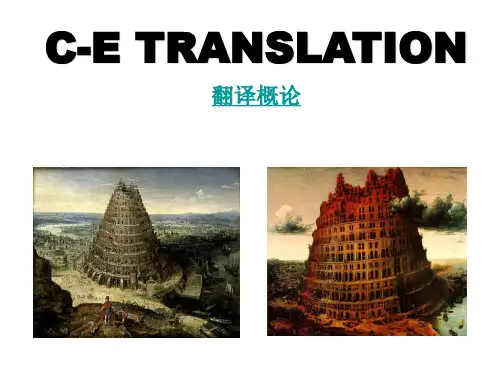
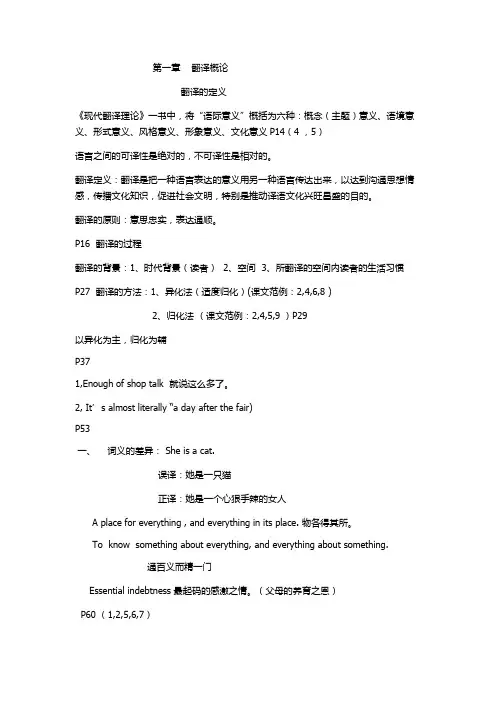
第一章翻译概论翻译的定义《现代翻译理论》一书中,将“语际意义”概括为六种:概念(主题)意义、语境意义、形式意义、风格意义、形象意义、文化意义P14(4 ,5)语言之间的可译性是绝对的,不可译性是相对的。
翻译定义:翻译是把一种语言表达的意义用另一种语言传达出来,以达到沟通思想情感,传播文化知识,促进社会文明,特别是推动译语文化兴旺昌盛的目的。
翻译的原则:意思忠实,表达通顺。
P16 翻译的过程翻译的背景:1、时代背景(读者) 2、空间 3、所翻译的空间内读者的生活习惯P27 翻译的方法:1、异化法(适度归化)(课文范例:2,4,6,8 )2、归化法(课文范例:2,4,5,9 )P29以异化为主,归化为辅P371,Enough of shop talk 就说这么多了。
2, It’s almost literally “a day after the fair)P53一、词义的差异: She is a cat.误译:她是一只猫正译:她是一个心狠手辣的女人A place for everything , and everything in its place. 物各得其所。
To know something about everything, and everything about something.通百义而精一门Essential indebtness 最起码的感激之情。
(父母的养育之恩)P60 (1,2,5,6,7)1、She was a total stranger to us.我们根本不认识她。
2、We are food for worm. 我们都是凡人。
3、enjoy your journey. 一路辛苦了。
4、You are among friends.这里又没有别人。
5、I have his ear, of course.他当然听我的话。
6、Your work leaves nothing to be desired.你的工作令人满意。
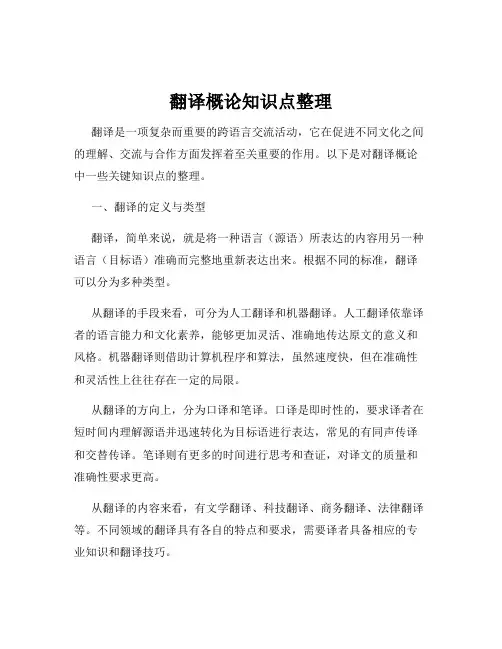
翻译概论知识点整理翻译是一项复杂而重要的跨语言交流活动,它在促进不同文化之间的理解、交流与合作方面发挥着至关重要的作用。
以下是对翻译概论中一些关键知识点的整理。
一、翻译的定义与类型翻译,简单来说,就是将一种语言(源语)所表达的内容用另一种语言(目标语)准确而完整地重新表达出来。
根据不同的标准,翻译可以分为多种类型。
从翻译的手段来看,可分为人工翻译和机器翻译。
人工翻译依靠译者的语言能力和文化素养,能够更加灵活、准确地传达原文的意义和风格。
机器翻译则借助计算机程序和算法,虽然速度快,但在准确性和灵活性上往往存在一定的局限。
从翻译的方向上,分为口译和笔译。
口译是即时性的,要求译者在短时间内理解源语并迅速转化为目标语进行表达,常见的有同声传译和交替传译。
笔译则有更多的时间进行思考和查证,对译文的质量和准确性要求更高。
从翻译的内容来看,有文学翻译、科技翻译、商务翻译、法律翻译等。
不同领域的翻译具有各自的特点和要求,需要译者具备相应的专业知识和翻译技巧。
关于翻译的标准,虽然众说纷纭,但大致可以概括为“信、达、雅”。
“信”指的是忠实于原文的内容,准确无误地传达原文的信息,不随意增减或歪曲。
“达”要求译文通顺流畅,符合目标语的语法和表达习惯,让读者能够毫无障碍地理解。
“雅”则强调译文要有文采,尽可能地再现原文的风格和韵味。
然而,在实际的翻译过程中,要完全达到这三个标准并非易事,需要根据具体的情况进行权衡和取舍。
比如,在科技翻译中,更注重“信”和“达”,而在文学翻译中,“雅”的要求可能会相对较高。
三、翻译的过程翻译不是简单的语言转换,而是一个复杂的思维过程。
首先是理解阶段。
译者需要对原文进行仔细的阅读和分析,理解原文的词汇、语法结构、语义以及背后的文化内涵。
这需要译者具备扎实的语言功底和丰富的文化知识。
然后是表达阶段。
在理解原文的基础上,译者运用目标语的词汇、语法和表达方式,将原文的内容重新呈现出来。
这要求译者能够熟练掌握目标语的语言规则,并具备灵活运用语言的能力。
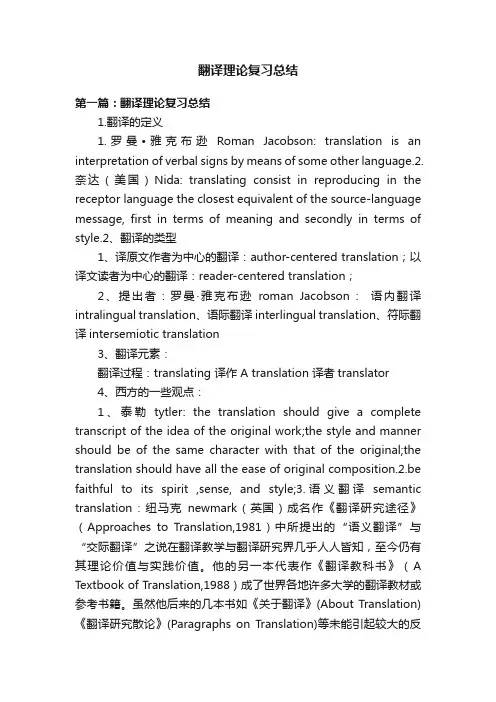
翻译理论复习总结第一篇:翻译理论复习总结1.翻译的定义1.罗曼•雅克布逊Roman Jacobson: translation is an interpretation of verbal signs by means of some other language.2.奈达(美国)Nida: translating consist in reproducing in the receptor language the closest equivalent of the source-language message, first in terms of meaning and secondly in terms of style.2、翻译的类型1、译原文作者为中心的翻译:author-centered translation;以译文读者为中心的翻译:reader-centered translation;2、提出者:罗曼·雅克布逊roman Jacobson:语内翻译intralingual translation、语际翻译interlingual translation、符际翻译intersemiotic translation3、翻译元素:翻译过程:translating 译作 A translation 译者translator4、西方的一些观点:1、泰勒tytler: the translation should give a complete transcript of the idea of the original work;the style and manner should be of the same character with that of the original;the translation should have all the ease of original composition.2.be faithful to its spirit ,sense, and style;3.语义翻译semantic translation:纽马克newmark(英国)成名作《翻译研究途径》(Approaches to Translation,1981)中所提出的“语义翻译”与“交际翻译”之说在翻译教学与翻译研究界几乎人人皆知,至今仍有其理论价值与实践价值。


翻译概论知识点总结翻译概论的研究内容非常广泛,包括翻译理论、翻译原则、翻译方法、翻译接受者的认知过程、翻译技术、翻译评价等方面。
在翻译概论中,我们可以了解到翻译的定义、分类以及与其他学科的关系,可以系统地学习和掌握不同语言和文化之间的对等关系,可以研究和分析翻译的规律和特点,可以探讨翻译活动的内在逻辑和思维过程,可以探索翻译技术和工具的应用,可以评价和分析不同翻译作品的质量和成就,可以洞察翻译行为的伦理和社会责任等等。
从学科发展的历史来看,翻译概论起源于古代的翻译实践和文学批评,发展于19世纪的语言学和社会学研究,成熟于20世纪的应用语言学和跨文化交际研究。
而在当今世界,翻译概论已经成为了独立的学科体系,并且在全球范围内迅速发展和壮大。
随着国际间交流与合作的日益加强,翻译概论必将面临更为广阔的发展空间和更为丰富的研究前景。
翻译概论的研究方法主要包括文献研究、实证研究、对比分析和案例分析等。
通过对相关文献的梳理和分析,可以了解到翻译概论的研究热点和前沿,可以学习到其他学者的研究成果和思想观点,可以拓展自己的学术视野和思维广度。
通过实证研究,可以验证和检验相关理论和假设,可以获取和积累实际的翻译数据和资料,可以分析和总结不同翻译实践的经验和教训。
通过对比分析和案例分析,可以发现翻译活动的规律和差异,可以评价和比较不同翻译作品的优劣,可以揭示和阐释翻译活动的内在机理和外在效果。
翻译概论的研究对象主要包括自然语言、人文文化和社会交往等方面。
从自然语言的角度来看,翻译概论涉及到的语言范畴和语言现象非常丰富,包括语音、语法、词汇、语用等方面。
不同语言之间存在着很多差异和共性,而翻译概论就是要研究和揭示这些差异和共性,促进不同语言之间的互译和互补。
从人文文化的角度来看,翻译概论涉及到的文学、历史、哲学、宗教、艺术等领域非常广泛,而翻译概论就是要研究和理解这些领域的内涵和外延,促进不同文化之间的相互理解和尊重。
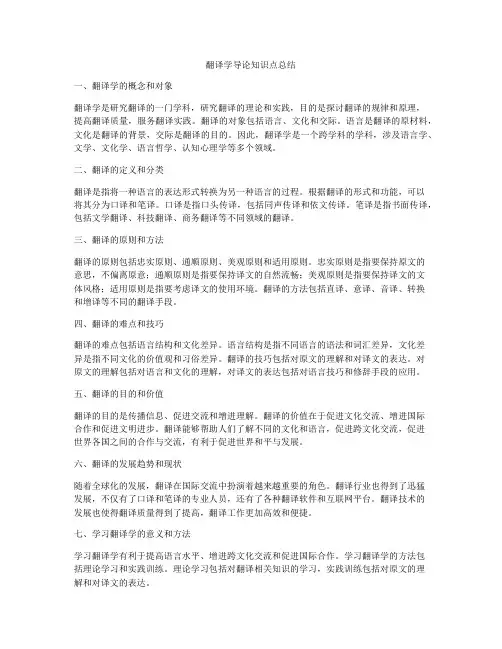
翻译学导论知识点总结一、翻译学的概念和对象翻译学是研究翻译的一门学科,研究翻译的理论和实践,目的是探讨翻译的规律和原理,提高翻译质量,服务翻译实践。
翻译的对象包括语言、文化和交际。
语言是翻译的原材料,文化是翻译的背景,交际是翻译的目的。
因此,翻译学是一个跨学科的学科,涉及语言学、文学、文化学、语言哲学、认知心理学等多个领域。
二、翻译的定义和分类翻译是指将一种语言的表达形式转换为另一种语言的过程。
根据翻译的形式和功能,可以将其分为口译和笔译。
口译是指口头传译,包括同声传译和依文传译。
笔译是指书面传译,包括文学翻译、科技翻译、商务翻译等不同领域的翻译。
三、翻译的原则和方法翻译的原则包括忠实原则、通顺原则、美观原则和适用原则。
忠实原则是指要保持原文的意思,不偏离原意;通顺原则是指要保持译文的自然流畅;美观原则是指要保持译文的文体风格;适用原则是指要考虑译文的使用环境。
翻译的方法包括直译、意译、音译、转换和增译等不同的翻译手段。
四、翻译的难点和技巧翻译的难点包括语言结构和文化差异。
语言结构是指不同语言的语法和词汇差异,文化差异是指不同文化的价值观和习俗差异。
翻译的技巧包括对原文的理解和对译文的表达。
对原文的理解包括对语言和文化的理解,对译文的表达包括对语言技巧和修辞手段的应用。
五、翻译的目的和价值翻译的目的是传播信息、促进交流和增进理解。
翻译的价值在于促进文化交流、增进国际合作和促进文明进步。
翻译能够帮助人们了解不同的文化和语言,促进跨文化交流,促进世界各国之间的合作与交流,有利于促进世界和平与发展。
六、翻译的发展趋势和现状随着全球化的发展,翻译在国际交流中扮演着越来越重要的角色。
翻译行业也得到了迅猛发展,不仅有了口译和笔译的专业人员,还有了各种翻译软件和互联网平台。
翻译技术的发展也使得翻译质量得到了提高,翻译工作更加高效和便捷。
七、学习翻译学的意义和方法学习翻译学有利于提高语言水平、增进跨文化交流和促进国际合作。
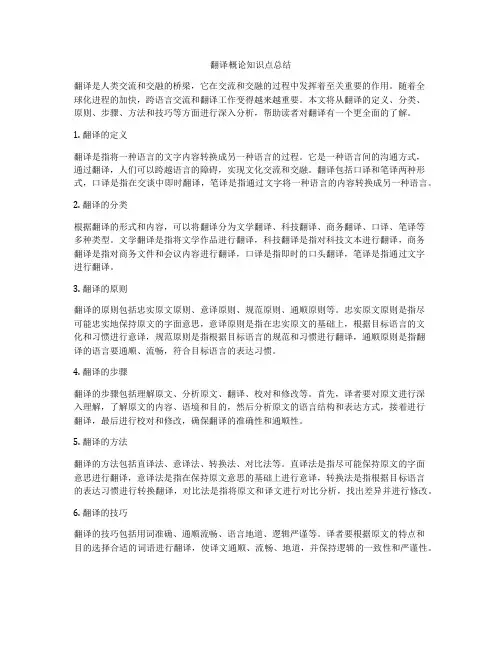
翻译概论知识点总结翻译是人类交流和交融的桥梁,它在交流和交融的过程中发挥着至关重要的作用。
随着全球化进程的加快,跨语言交流和翻译工作变得越来越重要。
本文将从翻译的定义、分类、原则、步骤、方法和技巧等方面进行深入分析,帮助读者对翻译有一个更全面的了解。
1. 翻译的定义翻译是指将一种语言的文字内容转换成另一种语言的过程。
它是一种语言间的沟通方式,通过翻译,人们可以跨越语言的障碍,实现文化交流和交融。
翻译包括口译和笔译两种形式,口译是指在交谈中即时翻译,笔译是指通过文字将一种语言的内容转换成另一种语言。
2. 翻译的分类根据翻译的形式和内容,可以将翻译分为文学翻译、科技翻译、商务翻译、口译、笔译等多种类型。
文学翻译是指将文学作品进行翻译,科技翻译是指对科技文本进行翻译,商务翻译是指对商务文件和会议内容进行翻译,口译是指即时的口头翻译,笔译是指通过文字进行翻译。
3. 翻译的原则翻译的原则包括忠实原文原则、意译原则、规范原则、通顺原则等。
忠实原文原则是指尽可能忠实地保持原文的字面意思,意译原则是指在忠实原文的基础上,根据目标语言的文化和习惯进行意译,规范原则是指根据目标语言的规范和习惯进行翻译,通顺原则是指翻译的语言要通顺、流畅,符合目标语言的表达习惯。
4. 翻译的步骤翻译的步骤包括理解原文、分析原文、翻译、校对和修改等。
首先,译者要对原文进行深入理解,了解原文的内容、语境和目的,然后分析原文的语言结构和表达方式,接着进行翻译,最后进行校对和修改,确保翻译的准确性和通顺性。
5. 翻译的方法翻译的方法包括直译法、意译法、转换法、对比法等。
直译法是指尽可能保持原文的字面意思进行翻译,意译法是指在保持原文意思的基础上进行意译,转换法是指根据目标语言的表达习惯进行转换翻译,对比法是指将原文和译文进行对比分析,找出差异并进行修改。
6. 翻译的技巧翻译的技巧包括用词准确、通顺流畅、语言地道、逻辑严谨等。
译者要根据原文的特点和目的选择合适的词语进行翻译,使译文通顺、流畅、地道,并保持逻辑的一致性和严谨性。

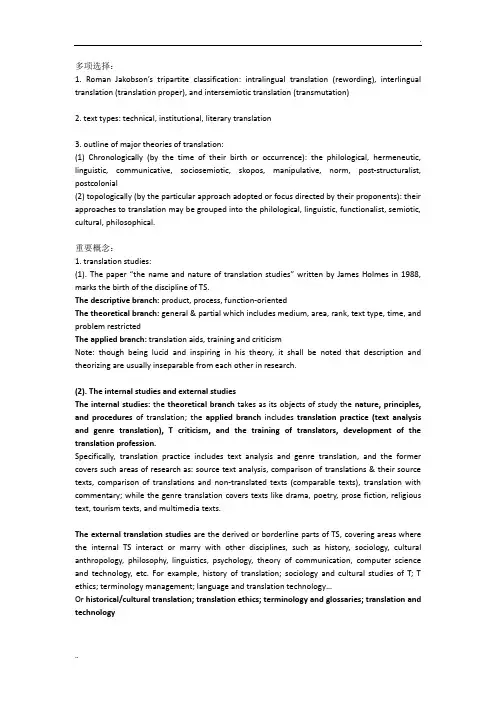
多项选择:1. Roman Jakobson’s tripartite classification: intralingual translation (rewording), interlingual translation (translation proper), and intersemiotic translation (transmutation)2. text types: technical, institutional, literary translation3. outline of major theories of translation:(1) Chronologically (by the time of their birth or occurrence): the philological, hermeneutic, linguistic, communicative, sociosemiotic, skopos, manipulative, norm, post-structuralist, postcolonial(2) topologically (by the particular approach adopted or focus directed by their proponents): their approaches to translation may be grouped into the philological, linguistic, functionalist, semiotic, cultural, philosophical.重要概念:1. translation studies:(1). The paper “the name and nature of translation studies” written by James Holmes in 1988, marks the birth of the discipline of TS.The descriptive branch: product, process, function-orientedThe theoretical branch: general & partial which includes medium, area, rank, text type, time, and problem restrictedThe applied branch: translation aids, training and criticismNote: though being lucid and inspiring in his theory, it shall be noted that description and theorizing are usually inseparable from each other in research.(2). The internal studies and external studiesThe internal studies: the theoretical branch takes as its objects of study the nature, principles, and procedures of translation; the applied branch includes translation practice (text analysis and genre translation), T criticism, and the training of translators, development of the translation profession.Specifically, translation practice includes text analysis and genre translation, and the former covers such areas of research as: source text analysis, comparison of translations & their source texts, comparison of translations and non-translated texts (comparable texts), translation with commentary; while the genre translation covers texts like drama, poetry, prose fiction, religious text, tourism texts, and multimedia texts.The external translation studies are the derived or borderline parts of TS, covering areas where the internal TS interact or marry with other disciplines, such as history, sociology, cultural anthropology, philosophy, linguistics, psychology, theory of communication, computer science and technology, etc. For example, history of translation; sociology and cultural studies of T; T ethics; terminology management; language and translation technology…Or historical/cultural translation; translation ethics; terminology and glossaries; translation and technologyThe internal studies and the external studies of translation are related and complementary to each other in that the research results in the former provide the latter with both a theoretical basis and a practical focus of concern while the research findings in external studies contribute to the depth and breadth of internal studies by providing new observations and new perspectives.2. definition of translation:According to Wilss (1995), translation is an action directed toward both the source text and the reader of the target language. Its procedure is determined by its function and it pursues a goal of enabling understanding between individuals of different linguistic and cultural communities. Nida and Taber (1969) regard translation as a communication-based task and define it as: Translation consists in reproducing in the receptor language the closest natural equivalent of the source language message, first in terms of meaning, and secondly in terms of style. (closest in meaning and style; acceptability; loss of information)-- translation as a kind of communication between different language group-- translation should communicate information or meaning3. theory:A theory, in the simplest sense, is just a view or understanding of something that concerns us. In modern science, it is generally understood or refers to a proposed explanation of empirical phenomena, made in a way consistent with scientific method. Theories are collections of hypotheses that are logically linked together into a coherent explanation of some aspect of reality and which have individually or jointly received some empirical support.The properties of a good theory: strong explanatory power that can effectively explain the subject matter it pertains to; strong predicative power which means it should proved a) reasonably adequate predictions about the properties not yet discovered of the specific object under investigation and b) a measure of predictability about the degree of success to be expected from the use of certain principles and procedures in the study of the subject matter.3. equivalence:A term used by many writers to describe the nature and the extent of the relationships which exist between SL and TL texts or smaller linguistic units.The nature of “equivalence”was successively discussed by prominent figures such as Jakobson, Eugene Nida, Peter Newmark, and Werner Koller.(1) Jakobson’s linguistic meaning and equivalence. He followed the relation set out by Saussure between the signifier (the spoken and written signal) and the signified (the concept signified). He stated that the signifier and signified form the linguistic sign, but the sign is arbitrary or unmotivated, thus there is ordinarily no full equivalence between ST and TT. He defined translation as “substituting messages in one language not for separate code-units (signifier) but to entire messages (signified) in some other language”.(2) Catford regarded the central task of translation as “defining the nature and conditions of translation equivalence” and there exists a distinction between textual equivalence and formal correspondence.(3) Nida, inspired by Noam Chomsky’s generative-transformational grammar, put forward a three-stage system of translation and used back-transformation to analyze the kernels undersome complicated surface structure. In terms of equivalence, he stated that there areformal equivalence which focuses attention on the message itself in both form and content, the message in the receptor language should match as closely as possible the different elements in the source language.Dynamic equivalence is based on the principle of equivalent effect, where the relationship between receptor and message should be substantially the same as that which existed between the original receptor and the message.There are four basic requirements of a translation.(4) Newmark put forward the notions of communicative translation and semantic translation. Communicative translation attempts to produce on its reader an effect as close as possible to that obtained on the readers of the original.Semantic translation attempts to render, as closely as the semantic and syntactic structures of the second language allow, the exact contextual meaning of the original.4. meaning:According to Nida, meaning is broke down into linguistic meaning, referential meaning and emotive meaning.In terms of traditional studies of meaning, the meanings of meaning are as follows:reference and sense: reference is the relationship between words and the things, actions, events, and qualities they stand for; sense is the place a which a word or phrase holds in the system of relationships with other words or phrases in the vocabulary of a language.From the perspective of sociosemiotics, there are 4 basic facts about meaning:1) meaning is a kind of relationship. Meaning is not really an entity (because words do not have meanings, people have meanings for words), but the relationship between a sign and something outside it2) there is a plurality of meaning: three kinds of relationship a sign may enter into –referential(semantic), pragmatic, syntactic (intralingual);a. Referential meaning (RM) (sign-real world entity)is chiefly connected with the topic of a communication. Its core elements are the external situation, the facts of the real world. Also known as informative, conceptual, cognitive meaning. But RM does not equal literal meaning (LM). E.g 挂号信;vice-chancellor;indian meal;国际学院;基础实验楼b.Pragmatic meaning (PM) (sign-user)may be divided into four subsets: identificational meaning (regional, historial background of the speaker); expressive meaning (emotional content of an expression might have in terms of the personality or individual creativity of the user, e.g murder & homicide); associative meaning(connotative meaning隐含意义); social meaning (channel of contact, e.g phatic forms of discourse; forms of address vous/tu; flatter; register); imperative meaning (conative meaning, operative or instrumental meaning)c. intralingual meaning (IM) (sign-sign) is related to the code: phonetic meaning; phonological meaning; graphemic meaning; morphological/lexemic meaning, syntactic meaning, discoursal/textual meaning3) style is meaning. S tyle in its linguistic sense is reduced to a group of pragmatic meaning and intralingual meanings.4) different meaning may carry different weight in different contexts.5. code: a system of signs or signals involved in the transmission of messages. Language as a code is a system of multiplicity, i.e. it is composed of diverse elements or has different aspects.6. sign: a thing that signifies or stands for another thing or things.7. signification: using signs to mean. A third item is included in the process of signification, that is, an abstract concept of the thing for which the sign stands.8. message: according to Nida and Taber, it consists of two aspects: meaning and style9. fusion of horizon: the meeting of different perspectives or backgrounds. So far as translation is concerned, this concept implies that a translator has to emerge from his own intellectual perspective and cultural background in order to assimilate what is foreign in a new light.总结自己学习情况:Taking the course “Introduction of Translation Studies” is conducive to the improvement of both my theoretical and practical inquiry on translation. It is a pity that we cannot cover all the items outlined in the syllabus such as the skopos theory and the manipulation school, which I find them an enlightening reading as I read them in Jeremy Munday’s “Introducing Translation Studies”.As far as I am concerned, the benefits by taking this course are twofold. First, owning to the systematic exemplifications and illustrations discussed in class, I have a better understanding of the major schools of translation chronologically and topologically. Equipped with the basic knowledge and systematic framework of translation studies, I can conduct my research or my future thesis paper from an in-depth perspective. The philological approach mainly concerning on the “word for word” or “sense for sense” debate, though案例分析:1. deep structure analysisThe surface structure is the syntactic structure of the sentence which a person speaks, hears, reads or writes. It is the actually observed structure of a sentence.The deep structure is much more abstract and it is considered to incorporate all information relevant to the single or unambiguous interpretation of a particular sentence.Nida believes that the English language possesses seven such basic structures, which he terms “kernels”–the minimal number of structures from which the rest can be most efficiently and relevantly derived.Nida advocated the back-transformation of complex surface structures onto an underlying level, in which the fundamental elements are objects, events, abstracts, and relationals.Four steps for analyzing and transferring complicated SL sentences(1) determine whether each word is an object, and event, an abstract, or a relational(2) identify the kernels, (making explicit the implicit constituent elements of the kernels: who are the recipient and agent?)(3) determine the semantic and logical relationships between kernels (grouping the kernels into related sets)(4) find out the most efficient way of representing the given relationships between kernels in the target language. (state these relationships in a form which will be optimal, i.e. closest to the form in the target language, for transfer into the target language)例子:the unique and mixed ethnic heritage of the population; the American defence of Bastogne sealed their (Nazi troops) fate; this land, which once barred the way of weary travelers, now has become a land for winter and summer vacation, a land of magic and wonder.2. transliteration 以义出音vs. translation: a terminological study of the rendition of a sutra text翻译:长答题(essay questions;optional):1. the philological school, which lays emphasis on the source text, including its production, transmission, and history of interpretation, a typical question raised with this school being that of whether the translator should bring the original to the target reader (liberal translation) or the target language reader to the original (literal translation).Philological tradition in the western history can be illustrated chronologically:a) roman times –word for word vs. sense for sense. Cicero & Horace & Quintilian: liberal translation; St. Augustine: literal translationb) the middle ages –debate between translation and unacceptable interpretation. St. Jerome, father of the church, translated the Bible into Latin, and developed the Ciceronian distinction between the undesirable “word for word”translation and the desirable “sense for sense”translation. Translator such as King Alfred in England perceived the task of translating the Bible as linked to the task of elevating the status of the newly developing language known as English, i.e. the Old English.c) the Renaissance –“copying” an original, but also creating a new text with an individual voice. Focus on how to strike a balance in between and how to remain faithful without being subservient.d) Reformation – doctrinal fidelity vs. possible heretical “mistranslation”. Martin Luther elevated and disseminated the usage of German by his translation of the Bible. Etienne Dolet, burn at the stake for his addition to his translation of one of Plato’s dialogues, advocated five principles in translation.e) the 17th & 18th centuries – diversion of the activity of translation: translation as recovery or imitation of classical text; as language learning exercise; as commercial enterprise. John Dryden reduces all translation to three categories: the triadic model: metaphrase, paraphrase, and imitation. The Port- Royal grammar put forward that “accuracy” in translation could somehow be measured on a qualifiable basis. Alexander Tytler reacted against Dryden’s “paraphrase” (loose translation) and set up three basic and celebrated principles of translation: complete transcript of ideas, style and manner of the same character, and all the ease of the originalf) the 19th century – romanticism and “creative translation”, which centered around the problem of whether translation could be considered as a creative or a mechanical enterprise.g) the 20th century – the philological tradition enduredIn conclusion, the methodology of this school is introspective, impressionistic, relying heavily on the researchers’and practitioners’intuition. Its central concepts are too abstract to be unequivocally understood and too fuzzy to serve as a reliable basis on which detailed theoretical analysis can be conducted and universally accepted conclusion drawn simply because different people may have different views of these concepts.2. the hermeneutic school, which concerns the interpretative process of the ST.The term “hermeneutics” is used in two senses: the part of Christian theology解经学and theory of understanding and interpretation of the significance of human actions, utterances, products, and institutions 阐释学。
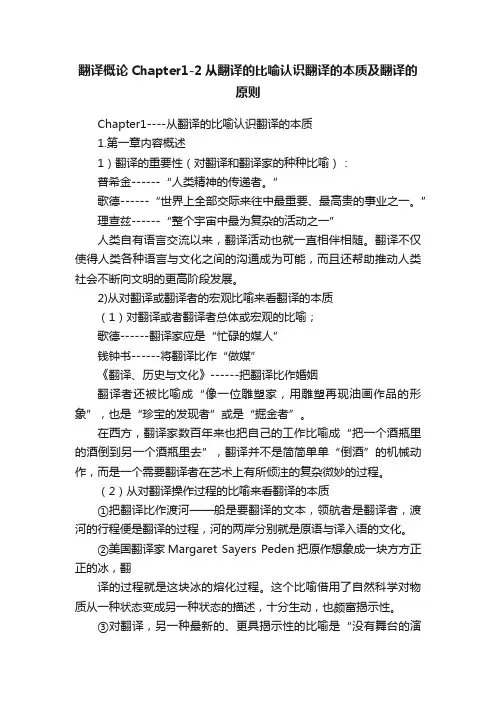
翻译概论Chapter1-2从翻译的比喻认识翻译的本质及翻译的原则Chapter1----从翻译的比喻认识翻译的本质1.第一章内容概述1)翻译的重要性(对翻译和翻译家的种种比喻):普希金------“人类精神的传递者。
”歌德------“世界上全部交际来往中最重要、最高贵的事业之一。
”理查兹------“整个宇宙中最为复杂的活动之一”人类自有语言交流以来,翻译活动也就一直相伴相随。
翻译不仅使得人类各种语言与文化之间的沟通成为可能,而且还帮助推动人类社会不断向文明的更高阶段发展。
2)从对翻译或翻译者的宏观比喻来看翻译的本质(1)对翻译或者翻译者总体或宏观的比喻;歌德------翻译家应是“忙碌的媒人”钱钟书------将翻译比作“做媒”《翻译、历史与文化》------把翻译比作婚姻翻译者还被比喻成“像一位雕塑家,用雕塑再现油画作品的形象”,也是“珍宝的发现者”或是“掘金者”。
在西方,翻译家数百年来也把自己的工作比喻成“把一个酒瓶里的酒倒到另一个酒瓶里去”,翻译并不是简简单单“倒酒”的机械动作,而是一个需要翻译者在艺术上有所倾注的复杂微妙的过程。
(2)从对翻译操作过程的比喻来看翻译的本质①把翻译比作渡河——船是要翻译的文本,领航者是翻译者,渡河的行程便是翻译的过程,河的两岸分别就是原语与译入语的文化。
②美国翻译家Margaret Sayers Peden把原作想象成一块方方正正的冰,翻译的过程就是这块冰的熔化过程。
这个比喻借用了自然科学对物质从一种状态变成另一种状态的描述,十分生动,也颇富揭示性。
③对翻译,另一种最新的、更具揭示性的比喻是“没有舞台的演④巴西翻译家——“食人者”对翻译者或者翻译的种种比喻尽管五花八门,但都有一个明显的特征,即它们基本上都是正面的,都包含对翻译者工作的褒扬,是确实还有少数比喻表达了对翻译或翻译者的否定或批评;如“翻译即背叛者等”。
2)翻译的本质翻译是一种文化传播的工具,在国与国之间、原语文化与译入语文化之间起着桥梁和纽带的作用;翻译不仅仅是文本从一种语言向另一种语言的过渡,也是文本之间、文化之间的一种协商过程,是以翻译者为中间人进行交流和斡旋的过程;翻译不仅仅是一门涉及语符转换、意义传递的技巧或技艺,更是一项极富创造性、挑战性的活动,是“一种艺术,一种需要译者像画家、表演家”那样具有高超创作才能的艺术。
第1章General Principles(概论)1.1 复习笔记一、Definitions of Translation(翻译的定义)Translation can be roughly defined as a reproduction or recreation in one language of what is written or said in another language.翻译即用一种语言来再现另一种口头或书面的语言文本所传达的意义。
1. Linguistic Views on Translation(语言学视角)Translating consists in reproducing in the receptor language the closest natural equivalent of the source-language message, first in terms of meaning and secondly in terms of style. (Nida & Taber, 1969:12)翻译就是在译语中用最贴切而又最自然的对等语再现原语的信息,首先是语义,其次是文体。
2. Cultural Views on Translation(文化视角)翻译不仅涉及语言问题,也涉及文化问题。
译者不仅要了解外国的文化,还要深入了解自己民族的文化。
(王佐良,1989)Translation is a process which occurs between cultures rather than simply between languages. (Shuttleworth & Cowie, 1997:35)翻译是一个发生在不同文化之间的过程,而不仅仅是语言之间的过程。
3. Literary Views on Translation(文学视角)文学翻译的任务是要把原作中包含的一定社会生活的影响完好无损地从一种语言移注到另一种语言中。
卡特福德英国《翻译的语言学概论》篇章等值翻译是把一种语言的话语材料用另外一种语言的等值话语予以替代行文对等形式对应尤金·奈达美国翻译是指从语义到语体在译入语中用最切近而又最自然的对等语再现原语信息动态对等功能对等巴尔胡大罗夫苏联《语言与翻译》意义不变尽可能完备的传达原文各种类型的语义,包括所指意义、实用意义和语言内部意义彼得·纽马克英国表达功能------ 语义翻译信息功能呼唤功能------- 交际翻译卡瑟琳娜·莱斯,汉斯·威密尔,克里斯蒂安·诺德。
德国功能学派功能翻译理论以原语为取向:竺法护西晋,尼古拉斯·封·维尔德国,赛珍珠美国以译入语为取向:支谦康僧会唐朝,鸠摩罗什东晋,西塞罗贺拉斯古罗马以翻译目的为导向的翻译标准威密尔德国泰勒特“翻译三原则”严复“信达雅”翻译标准:主观向客观、散论到系统、静态向动态、单一向多元发展第三章佛经翻译对中国文化产生的影响语言方面:佛经翻译大大丰富了汉语词汇;在语法方面,汉语受佛经翻译的影响也不少文学方面:印度寓言故事神话传入中国,对中国文学题材内容有影响;对我国文学的思想情趣产生影响;汉译佛典对我国文学文体方面有巨大影响哲学方面:佛教对道教的影响;对儒家思想体系的影响,沿用了佛学的辩证逻辑思路翻译传递的是文化信息;语言是文化的基础,是文化得以流传的载体,是文化的镜子。
译者的责任:微观上,正确处理文字技术层面上的责任;宏观上,促进社会发展和文化交流方面的责任译者在技术层面上的责任:既不能对不起原作者,也不能对不起译文,往往也就是译者自己的国文得其精而忘其粗,在其内而忘其内译者在社会和文化层面上的责任:要对社会负责;要有稳定的立场译者的素质:彼得·马克:本国语方面,掌握丰富的词汇和各种句型;精通外语;能顺利用本国语表达原著意义尤金·奈达:熟悉原语;精通译语;充分了解所译题材;具备“移情”本领;具备语言表达的才华和丰富的文学想象力第六章纽马克《翻译教程》交际翻译将原语文本的语境意义以其思想内容和语言形式都容易为译入语读者所接受和理解的方式准确地传递出来汉斯·威密尔翻译是一种目的性行为(功能学派)目的论的核心概念:翻译方法和翻译策略必须由译文预期目的或功能来决定施莱尔马赫德国将翻译方法归为两类1、尽量不动读者而将原作者拉过来,即归化2、尽量不动原作者,而将读者推过来,即异化(施莱尔马赫本人推崇)雅各布逊从符号学的角度将翻译分成三类:语内翻译、语际翻译、符际翻译总结:翻译不仅仅是纯语言间的文字转换,而首先是一种交际行为,是为了达到特定环境和条件下的特定交际目的第七章翻译活动的处理方式分类:全译;节译、摘译、编译、译述(边翻边译)文体分类:文学翻译、非文学翻译活动方式分类:笔译、口译乔治·斯坦纳美国阐释学的角度出发,将翻译过程归纳为:信任、进攻、吸收、补偿翻译过程主要是理解与表达的过程,理解是翻译的第一步第十章直译和逐字译的区别直译照顾到译入语的语法规范,对原文形式作必要的调整,文字通顺;逐字译不顾译入语的语法规范和表达习惯,视原文为神圣不可侵犯,一味追求形式对应,文字晦涩生硬意译的定义张今:强调意译的文字同原文相比,采用了“新的表现法”;范仲英:强调译文表达的“自然流畅”;孙致礼:强调传达原文的精神主旨,为此原文的表现形式是可以牺牲的;许渊冲:将直译和意译进行对比,强调忠实于原文是最起码的要求。
翻译概论课后参考答案翻译概论课后参考答案翻译是一门复杂而有趣的艺术,它承载着沟通和理解的重要使命。
在全球化的时代背景下,翻译的作用变得愈发重要。
无论是商务交流、文化交流还是学术交流,翻译都扮演着桥梁的角色。
然而,翻译并非简单的语言转换,而是一种需要技巧和灵感的创造性过程。
首先,翻译需要对源语言和目标语言的深入理解。
语言是文化的载体,每种语言都有其独特的表达方式和文化内涵。
翻译者需要熟悉两种语言的语法、词汇和习惯用法,以确保准确传达原文的意思。
此外,翻译者还需要了解源语言和目标语言的文化背景,以避免文化差异带来的误解。
例如,英语中的“the early bird catches the worm”在中文中可以翻译为“捷足先登”,但直译成“早起的鸟儿有虫吃”可能会让读者感到困惑。
其次,翻译需要灵活运用不同的翻译策略。
根据不同的文本类型和目的,翻译者可以选择逐字翻译、意译或改写等不同的翻译方法。
逐字翻译可以保持原文的结构和用词,但可能会导致目标语言不流畅。
意译则更注重传达原文的意义,而不拘泥于字面表达。
在实际翻译中,翻译者需要根据具体情况灵活运用这些策略,以确保翻译的准确性和通顺性。
此外,翻译还需要具备良好的研究和分析能力。
在面对专业领域的文本时,翻译者需要具备相关领域的知识,并能够进行深入的研究和分析。
例如,在医学翻译中,翻译者需要了解医学术语和流程,同时还需要查阅相关资料,以确保翻译的准确性和专业性。
翻译者还需要具备较强的解决问题的能力,能够在遇到困难和歧义时找到最合适的翻译解决方案。
最后,翻译需要不断的学习和提升。
语言是一门活的艺术,不断变化和发展。
翻译者需要保持对语言的敏感度,并不断学习新的词汇和表达方式。
此外,翻译者还需要关注行业的发展和趋势,了解新的翻译工具和技术,以提高翻译的效率和质量。
只有不断学习和提升,翻译者才能跟上时代的步伐,为各种交流提供优质的翻译服务。
总之,翻译是一门需要技巧和创造力的艺术。
理论复习:1. 严复的翻译理论:信、达、雅(faithfulness; expressiveness; elegance)2. 翻译的基本过程(程序)包括:理解、表达、修改comprehension (or understanding); expression (or representation); testing(checking).3. 翻译的要素包括:译者(translator), 作者(author), 源语言(source language), 目标语言(target language),原文读者(source-text readers), 译文读者(target-text readers) 4.During the process of representation, we should try to avoid 翻译过度over-representation and 翻译不足under-representation which means that the translator can omit anything of the source text at will or overlook the features of the source text.5.教材中常见的翻译方法有:annotation加注, paraphrase释义分译, amplification; 增词, omission,减词, shift of perspective; 视角转换, adaptation(or domestication)归化, division分译and combination合并. (见下面解释)6.在翻译中使用增词法(amplification)主要是出于语法需要grammatical need(s),语义需要semantic need(s),修辞需要rhetorical need.7. 现代英语最主要的特征是形合(Hypotaxis)汉语是意合(parataxis)8. The sociosemiotics-oriented principle (社会符号学) for translation requires us topay due attention to the three types of meaning in translation: designative meaning(指称意义), linguistic meaning (言内意义)and pragmatic meaning (语用意义). (见课件)annotation加注,如:1. The Beat Generation 跨掉的一代(指二十世纪五十年代初在美国出现的一个文学流派,也指他们所代表的一代人.他们不满于战后美国的社会现实,否定传统的文化道德和价值观念,追求无拘无束的自我实现和自我表达.);2. The Fifth Avenue 第五大道(指纽约曼哈顿区第34街到第59街这一片区域.街上到处都是百货商店以及各种商铺,也是万圣节游行的必经之地.现已成为高贵与富有的象征.);3.The American Dream 美国梦(即美国式的民主与自由.不依赖世袭的物质条件和社会地位,白手起家的个人奋斗精神.));paraphrase释义分译,如:1) I am no Hamlet. 我决不犹豫.)2) I wonder whether he is a Trojan Horse.我不知道他是否是个内奸.)3) The goalkeeper is the heel of Achilles.那守门员太弱是致命的缺陷. )amplification; 增词,如:(A) For the sake of grammar1. One interesting study was successfully done with chimps. Six chimps were trained to operate a special vending machine. One ripe grape came out for each while token put into the slot.曾经对黑猩猩成功地进行了一项有趣的实验,实验对六只黑猩猩进行训练,让它们操纵一台专用售货机,往投币孔里塞入一枚白色筹码可得到一颗热葡萄.(增量词)2. --- observing the deer as their behavior changed from more activity in summer and fall toless as winter progressed, followed by an increase again in the spring as the snow melted.--- 观察鹿是如何从夏季的活动频繁状态慢慢进入冬季的不频繁状态的,而到冰雪逐渐融化的春季时,它们的活动又是如何增多起来的.(增副词)3. Her eyes were filled with tears.她双眼满含泪水.4. The old man said, "They say his father was a fisherman. Maybe he was as poor as we are."老头说:"听人说,他爸爸过去是打鱼的,他以前八成跟咱们现在一样穷."(B) For clarity5. Studies serve for delight, for ornament, and for ability.读书足以怡情,足以傅采,足以长才.6. Earl and I decided to walk our dog. Somehow our path took us toward the park, across the footbridge high above the rolling waters of the Los Angeles River. It is like a dream to me now, floating through my mind in slow motion. Many children were playing close to the waters.我和艾勒决定把狗带出去溜溜,不知不觉朝公园走去,公园就在小桥那边,桥下很深的地方,汹涌的落杉矶河水滚滚流过.现在回想起来,就仿佛是一场梦,当时的情景还在脑海里缓缓流动.那一天,许多小孩在靠近水边的地方玩耍.(增主体和时间状语)7. With this in mind, he decided to revive scholasticism as an academic lark to challenge the Sputnik-panicked classrooms of America.考虑到这一点,他便决定重新搬出中世纪经院哲学的一套来开个学术性玩笑,向惊恐于苏联第一颗人造卫星的美国课堂教育发出挑战.(增反映背景情况的词)(C) For the sake of rhetoric8. All is not gold that glitters.闪闪发光的东西不一定都是金子.9. We all enjoy applause, compliments and praise.我们都喜欢博得掌声,听到赞扬或受到称赞.10. This power is strong enough to shatter complacency.这种力量足以打破自满情绪.(增表具体的词)omission,减词1. A soldier must obey orders.军人必须服从命令.(省冠词)2. When the pressure gets low, the boiling point becomes low.气压低,沸点就低.(省动词)3. It was an early September day, cool and bright and just right for running, and I was in thefirst few miles of a 10.5-mile race over a course through steep exhausting hills.那是九月初的一天,秋高气爽,阳光明媚,正是赛跑的好时光.我正参加一场10.5英里的比赛,刚跑了几英里.比赛路线要穿越一些陡峭,使人精疲力竭的山坡.(省连词)4. It is conflict and not unquestioning agreement that keeps freedom alive.使自由保持活力的是冲突而不是绝对的一致.(省强调句中的it)5. One must make painstaking efforts before one could succeed in mastering a foreign language. 要掌握一门外语,非下苦功夫不可.(省代词)6. Never trouble yourself with trouble till trouble troubles you.不要自寻麻烦.(省名词)7. Where there is a will, there is a way.有志者事竟成.(省表条件的连词)8. The joint decision to build the Tunnel was announced by President Francois Mitterrand and Prime Minister Margaret Thatcher in a ceremony at Lille on 21 January.一月二十一日,弗朗索瓦o密特朗总统和玛格丽特o撒切尔首相在里尔举行的一次仪式上宣布了联合修建英法隧道的决定.(省介词)9. University applicants who had worked at a job would receive preference over those who had not.报考大学的人,有工作经验的将优先录取.(修辞性省略)10. As it is late, let us go to bed.不早了,睡吧!(省重复部分)shift of perspective; 视角转换,如:1. The University of San Francisco is located near the Golden Gate Park.旧金山大学座落在金门公园附近.(语态的转换)2. Her parents are both in their seventies.她父母都已年过古稀.(表达方式的转换)3. If children are so well able to learn their mother tongue, it is precisely because they plunge themselves into the sea of language instead of reading a few textbooks only.孩子们之所以能把自己的母语学好,恰恰是因为他们投身于语言的海洋之中,而不单单是读几本教科书而已.4. You can mass-produce … incredible quantities of facts and figures. Y ou cannot mass-produce knowledge, which is created by individual minds, drawing on individual experience, separating the significant from the irrelevant.你可以大批制造……数量惊人的事实与数字,但不可能大批生产知识,因为知识是个人头脑用个人经验,经过去伪存真后创造出来的.(定语从句转换成原因状语从句)5. "Coming!" Away she skimmed over the lawn, up the path, up the steps, across the verandah, and into the porch."来啦!"她转身蹦跳着跑了,越过草地,跑上小径,跨上台阶,穿过凉台,进了门廊.(介词转换成动词)6. Highway and air traffic came to a standstill in most of Eastern Washington.华盛顿州大部分地区的公路交通和空中航线都已陷入停顿.(名词转换成动词)7. I believe equally that it is in the interests of the world as a whole that Europe should increasingly unite and speak with a common voice.我同样认为,欧洲应该日益团结起来,并且用一个共同的声音说话,这是符合全世界的利益的.(词序调整)8. Little did I then know the meaning of war and what it was in reality.当时我确实不大懂得战争的意义以及战争实际上是怎么回事.(词序调整)9. It is a good workman that never blunders.智者千虑,必有一失.(反说正译)10. Keep off the lawn!请勿践踏草地!(正说反译)adaptation(or domestication)归化,如:⑴Lead a dog's life 过着牛马不如的生活⑵Jack of all trades 三脚猫⑶A drowned rat 落汤鸡⑷Let the cat out of the bag. 露马脚⑸Every dog has his day. 风水轮流转.⑹Don't shed crocodile tears to me; you know you are really glad that they're met with misfortune.别在我面前装慈悲,你自己知道你对他们遭遇不幸有多高兴.⑺Your honor, I confess the corn. I was royally drunk.法官先生,我承认错误,我当时酩酊大醉了.⑻Don't play your ace in the hole until the critical moment.不到关键时刻不要亮出你的绝招.⑼The gravy train is just not for me.这种油水足的美差压根儿轮不到我.⑽George Washington adopted a Fabian policy during the war of Independence.乔治·华盛顿在独立战争期间采取过拖延战术.);division分译,如:1、He had left a note of welcome for me, as sunny as his face. 他留下一封信,对我表示欢迎,那信写得热情洋溢,一如其人.2、Our little romantic friend formed visions of future for herself. 我们的小朋友一脑袋幻想,憧憬着美好的未来.);combination合并,如:His father had a small business in the city of Pisa. This city is in the north of Italy near the sea. 他的父亲在意大利北部近海的比萨开小铺.)。
翻译概论课外重点整理翻译理论一:中:古代:安世高:佛经翻译第一人支谦:《法句经序》,第一部翻译理论书;“因循本旨,不加文饰”道安:“五失本”;“三不易”---- 求真&喻俗三大佛经翻译家鸠摩罗什:意译玄奘:“五不翻”(音译)&8种详细分工真谛:严琮:“八备”:1,2,5,6—人格修养1.诚心爱法,志愿益人,不殚久时,其备一也;(诚心热爱佛法,立志帮助别人,不怕费时长久)2.将践觉场,先捞戒足,不染讥恶,起备二也;(品行端正,忠实可信,不惹旁人讥疑)5.襟抱平恕,器量虚融,不好专执;(度量宽和,虚心求益,不可武断固执)6.耽於道术,淡於名利,不欲官衔;(深爱道术,淡于名利,不想出风头)明清:徐光启:“会通超胜”,《几何原本》李之藻:创译,“借我华言,翻出西译”杨廷均:译难;要培养翻译人才王徵:三类书:资耳目(语言);资手足(科技);资心(哲理)魏象乾:《藩清说》,古代最为精辟的一篇翻译理论书马建中:三类书应翻:1.各国时政2.居官考定之书3.外洋学馆应读之书许渊冲:优势(音形意)严复:信达雅(不考8大名著)-- 汉以前的字法句法(表现力强)林纾:(用古文做翻译)外国小说第一人瞿秋白:“翻译绝对不允许错误”鲁迅: 易解&保持原作风姿;“守信而不顺”朱生豪:保持神韵;反逐字句对译郑振铎:文学是绝对能够翻译的;翻译三原则:首次引进,忠实,折中。
“翻译是媒婆和奶娘”傅雷:“神似”:神韵和风格林语堂:忠实,通顺,美感,胸怀两种文化,“神似”王佐良:读者至上钱钟书:“化境”--- 躯体换了一个,但精魄依然故我“做媒”季羡林:1. 印度来的水;2. 西方来的水二:西(英美德是重点)传统翻译理论:1. Linguistic turn 翻译转向2. cultural turn 文化转向中世纪—人文少,宗教多《七十子希腊文本》—最早拉开帷幕罗马人被推崇为“西方翻译理论的发展者”西塞罗:不要字当句对,要保留总的风格,推崇自由翻译贺拉斯:译入语借鉴(拉丁语没有的,可借鉴与希腊语),丰富了拉丁语昆体良:“翻译要与原作进行竞争”;“翻译也是创作”对世俗文本翻译之上的文艺学派,都比安世高早哲罗姆:《通俗拉丁文本圣经》(强调直译&靠对原文的正确理解而不是“上帝的召唤”)。
L1 中国翻译发展:1.The earliest historical documents 周朝《周礼》and 《礼记》2.汉代传译的《四十二章经》是佛经最早的中译本3.东汉桓帝时,安世高——《明度五十校计经》是正式见于史籍记载的翻译佛经4.ZhiQian(支谦) extremely literal translation. follow the original intention of the authorwithout any embroidery" (因循本旨,不加文饰)5.Dao An (道安) literal translation translate according to the originalwithout any additioin and deduction" ( 案本而传,不令有损言游字 ) Personal activity---official organization ( fifth century )6.Kumarajiva ( 鸠摩罗什) He emphasizedthe accuracy of translation. freetranslation the first to suggest translators sign their names totranslated works.7.The First Peak of Translation in China :from the Sui dynasty (581-618)to the Tang dynasty (618-907) thoroughly studied translation theory.translators should: " (1) be faithful to the Buddhist doctrine, (2) be ready to benefit the readers (Buddhist believers), (3) concentrate on the translation of the Buddhist doctrine rather than translating for fame."8.玄奘:将佛经由梵文译成汉文,而且把老子著作的一部份译成梵文,成为第一个把汉文著作向国外介紹的中国人Contribution to theory: set down the famous translation criteria that translation "must be both truthful and intelligible to the populace."( 既須求真,又須喻俗,意即忠实、通順)Aiming to achieve an intelligibility of the translation for the target language readers9.P3. 明清之际的科技翻译Western Christian missionaries (利玛窦...) Assisted by Chinesecollaborators ( 徐光启、李之藻) 利玛窦、徐光启:《几何原本》、《测量法义》,利玛窦、李之藻《同文算指》,利玛窦:论语、孟子、大学、中庸——拉丁文第二次翻译高潮(1)T he subject of translation shifted from Buddhist scriptures toscientific and technological knowledge;(2)t ranslators in this period of time were mainly scientists andgovernment officials who were erudite scholars, and the westernmissionaries who brought western knowledge to China.10.the 3rd peak :from the mid 19th century to May 4th Movementemphasis on Western works of social soiences, military sciences and literature11.林则徐( 1785-1850):Geography ( Gazette of the Four Continents 《四洲志》);李善兰( 1811-1882):Geometry 《几何原本》;严复:《天演论》、《原富》;林纾:《茶花女》,《块肉余生述》,《黑奴吁天录》《鲁滨逊漂流记》12.Translation in Modern period ( 1919-1949 ):focus on the translation ofKarl Marx's (1818-1883) and Lenin's (1870-19224) works on socialist and communist theories (社会主义和共产主义) , and the translation and re-translation of western literature. 朱生豪:莎士比亚戏剧全集张谷若:德伯家的苔丝》和《还乡》,哈代的《无名的裘德》、狄更斯的《大卫· 考坡菲》P7,鲁迅,矛盾,郭沫若,付东华,傅雷,林语堂13.杨必:玛丽亚?埃杰窝斯的《剥削世家》,翻译萨克雷( W. M. Thackeray)的VanityFair (《名利场》杨宪益和戴乃迭:《红楼梦》《老残游记》《离骚》《儒林外史》《鲁迅选集》《奥德修纪》《卖花女》许渊冲:翻译了《诗经》、《楚辞》、《李白诗选》、《西厢记》、《红与黑》、《包法利夫人》、《追忆似水年华》等众多名著。